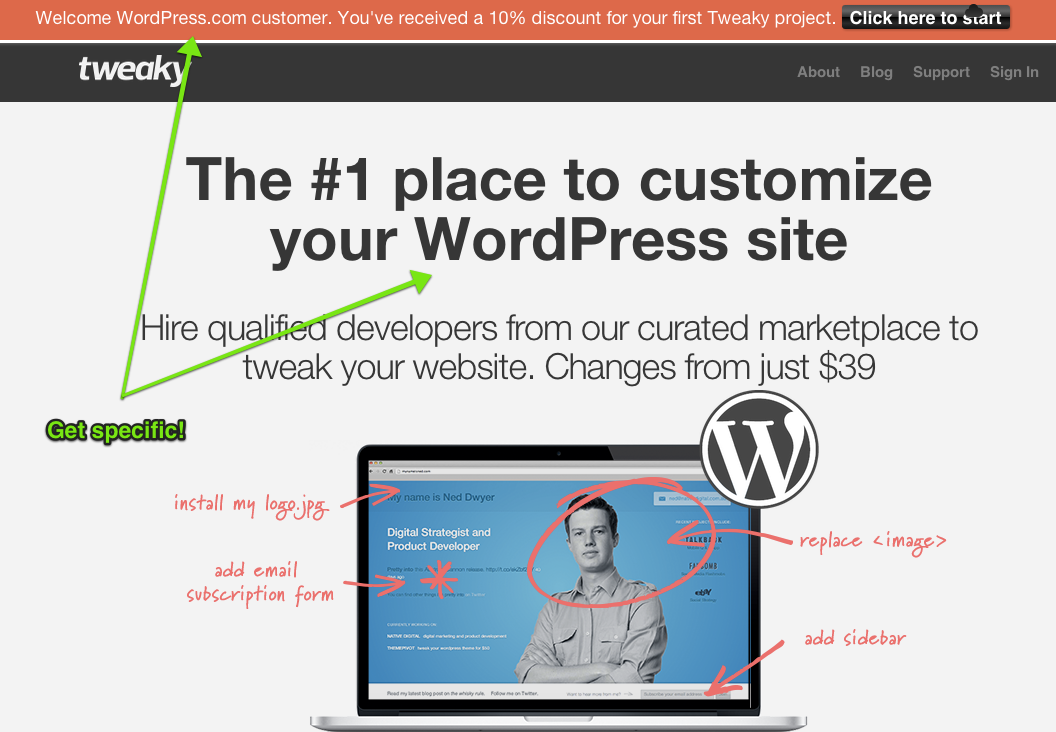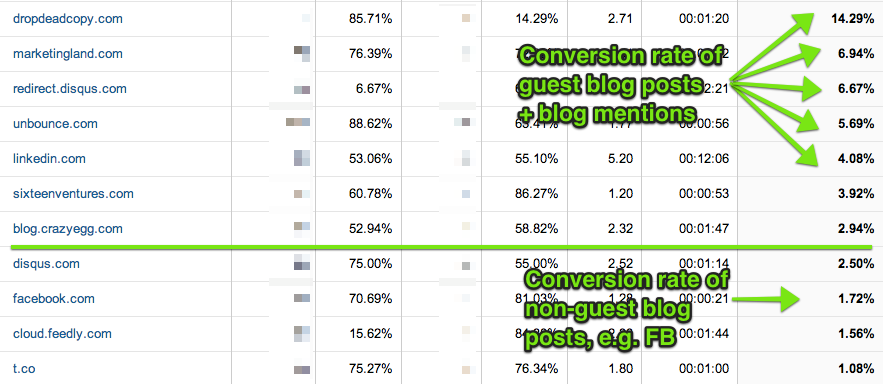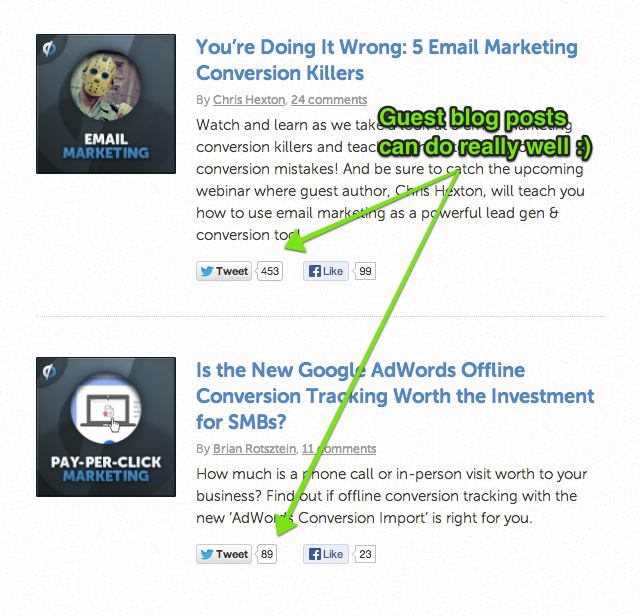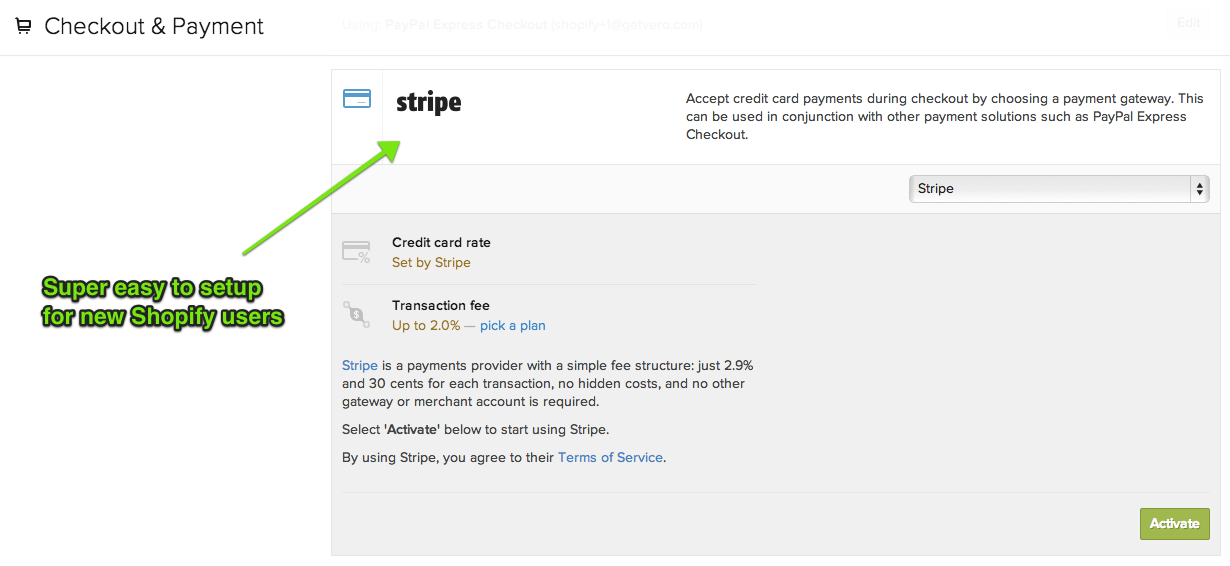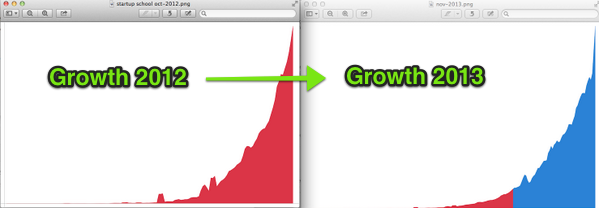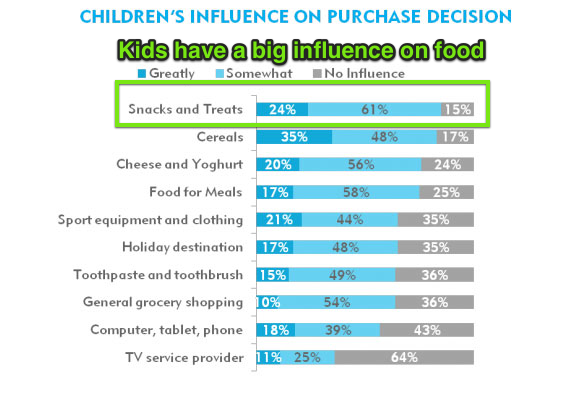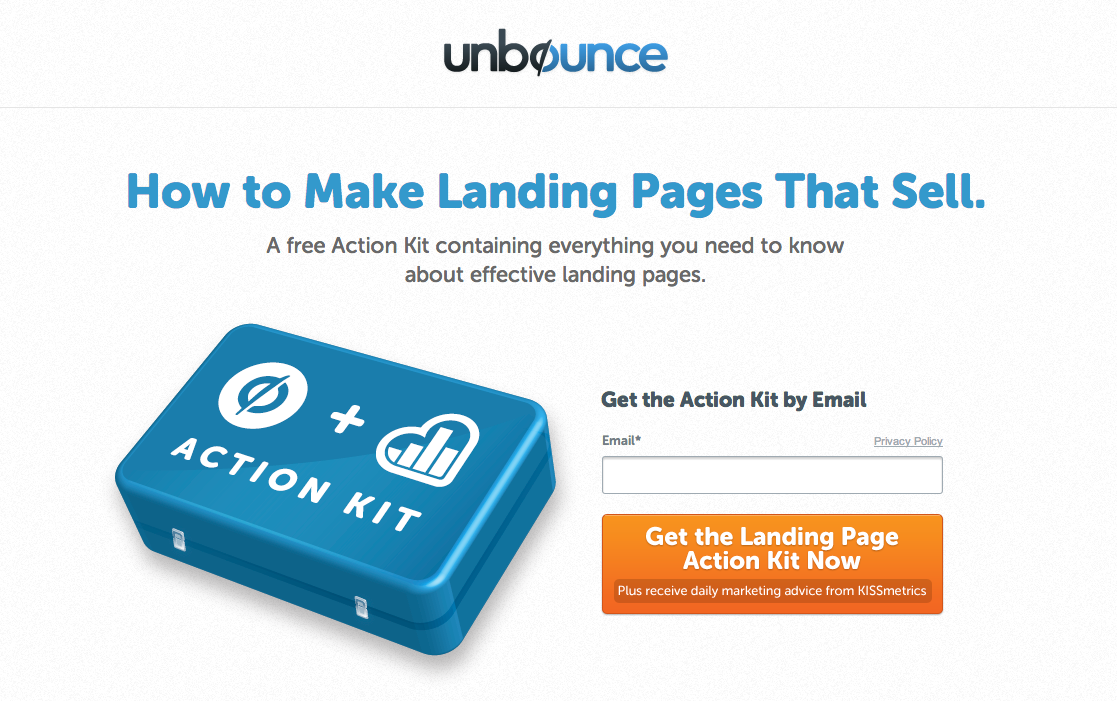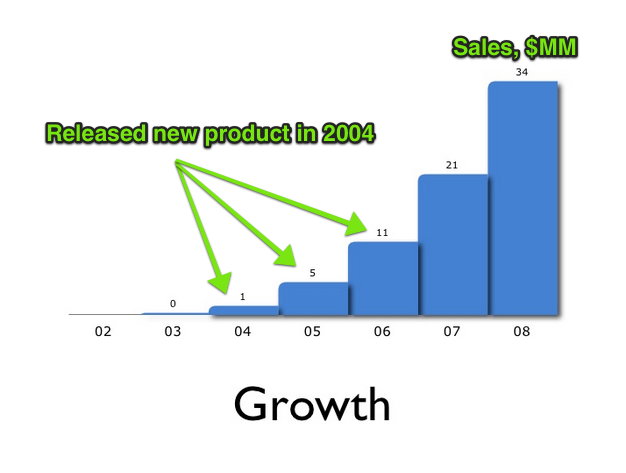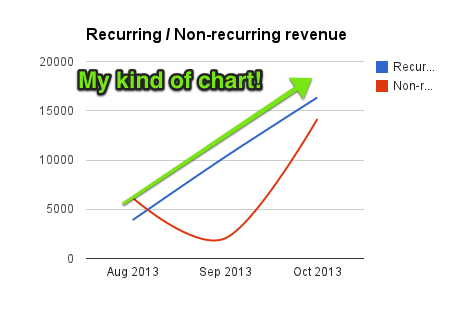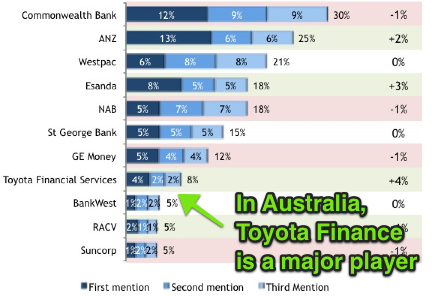- All Posts
- /
- How To Growth Hack Using Partnerships: An Online Marketing Strategy
How To Growth Hack Using Partnerships: An Online Marketing Strategy
Other-
 Chris Hexton
Chris Hexton
-
Updated:Posted:
On this page
Growing quickly is about leverage. The best way to get leverage is to get access to the audience of others.
Enter partnerships. A good partnership has to ability to deliver qualified visitors to your site. Visitors that will actually buy.
Building up a marketing channel that consistently drives people into the top of your funnel from scratch takes time.
Take content marketing. Here’s what Neil Patel, founder of KISSmetrics, has to say from a post on Getting Blog Subscribers:
Back in the day when blogging was the only thing in town…you would slowly accumulate a following and eventually reach the status of a popular blogger. Sadly, that model would never work today.
Neil’s point is that growing organically takes way too long.
Every marketer struggles with distribution. How do you get the word out about your product?
Using the right strategies makes all the difference: lack reach and you won’t attract enough new customers, lack relevance and you won’t attract the right customers, lack depth and the channel won’t grow with you.
Here’s a list of proven ways to approach a successful growth strategy using partnerships. Use this list to get ideas in order to develop your own game-changing online marketing plan!
Solve a problem for your distribution partner
The term partnership implies that there are benefits for all parties involved.
The best way to get in front of an audience you want access to is to solve a problem for your partner.
Tweaky makes it easy for non-tech-savvy business owners to have their website altered. WordPress bloggers might use it to have social media share buttons added or a custom call to action container delivered, for example. Ned Dwyer, a Co-Founder of Tweaky recently shared the success they have had in partnering with WordPress.com.
Ned realized that people host on WordPress.com for its ease-of-use and. In light of this, they’re generally run by those that don’t have great technical expertise, those that will need a lot of advice when it comes to customization. With WordPress powering nearly 20% of the world’s websites, you can imagine the number of technical support queries they get on their forums. Ned also realized that this is not WordPress.com’s core business: it was an opportunity for Tweaky to solve a problem not only for customers but for WordPress as well.
A fantastic partnership was born. WordPress.com now recommends Tweaky as a support option, bringing extremely qualified leads to Tweaky and saving WordPress.com a lot of time supporting non-paying customers.
“Partnerships are a tricky beast because there are so many stakeholders involved. There is you and your customers and then, your partner and their customers. To create a great partnership you need to be able to deliver value to all four of these stakeholders. When you can structure a partnership deal to look after all of these stakeholders you’re onto a winner. That is an opportunity for rapid growth for everyone.” Ned Dwyer, www.tweaky.com
Win-win.
The same principle is in effect whenever you guest post on other blogs. One of the primary challenges of running a blog is maintaining consistent, high-quality, content.
Enter the guest post. Unbounce frequently work with other entrepreneurs and bloggers to augment their own fantastic content efforts.
The reason guest posts work is that they benefit the host by reducing their content load and increasing their social reach, as the guest blogger will share the post as well. Having frequently guest posted for Unbounce myself the benefit of guest posting as a partnership and distribution strategy is clear: the face time in front of Unbounce’s highly-engaged audience pays off.
Here’s how qualified the visitors are from blog posts we’ve done, making guest blogging a real win:
Likewise, here’s proof a guest post can be ultra successful for Unbounce too:
Solve a problem for your partner and you will be successful.
Online payments processor, Stripe, are being incorporated into products everywhere. Squarespace, Shopify and others are offering Stripe as a payment gateway to their customers in their interface.
Obviously not easy to achieve, but creating an extremely friction-free and useful product will encourage potential partners to incorporate what you offer. Stripe solves a huge pain point for the customers of the businesses integrating them, such as Shopify.
To get started selling, Shopify customers must enter a way to accept payments. In other words, getting a payment gateway is a point of friction for the customers of Shopify, a tool that makes it awesomely easy to setup online stores. Stripe’s product is so good that it actually makes it easier reduces the friction for a first time Shopify customer, giving them an option to open a merchant account instantly.
Thanks to this utility, Stripe solves a huge problem for Shopify: it gets their customers on board faster. Faster engagement generally means higher activation means much higher conversion to paid subscriptions and, ultimately, customer lifetime value.
Just like the first two examples, Stripe is solving inherent problems for it’s partners, and it’s killing it:
Note: This is trickier to engineer than the first two examples but it shows the power of truly solving a pain point for your partner.
How you can use it: Think about products that are complimentary to your own. How can you help the creators of those products solve a problem they have?
Create something bigger than the sum of your parts
Another way to form a solid partnership is to give something away in order to get something in return. By combining your efforts you can work with your partner to extend the total reach of a campaign, benefiting both you and your partner immensely.
One of the world’s most ubiquitous examples is the McDonald’s Happy Meal:
The inclusion of a toy along with the food is marketing genius and has all the hallmarks of a great partnership:
- It gives McDonald’s a new marketing angle. Television and billboard ads for specifically for the Happy Meal bring children and their parents to McDonalds.
- The Inclusion of ‘series’ or ‘collectibles’ in a Happy Meal encourage return visits to complete a collection.
- The brand behind the toys, movies or products being advertised in the Happy Meal get direct access to McDonald’s patrons and those influenced by their marketing. They double their marketing efforts instantly.
Research conducted by Time in 2010 revealed that a crazy 40% of US parents admitted their children asked for McDonald’s at least once per week. Other studies have shown the profound impact children can have on the buying process: suggesting that nearly $9 billion dollars worth of cars sales each year are based primarily on the child’s decision.
The point is that, combined, both McDonald’s and the marketing partner create a campaign that is more effective than were they to act alone. The Happy Meal gives McDonald’s the chance to up-sell to parents, bring children back week-after-week and utilise the success of movies, toys and other franchises to sell it’s products whilst the marketing partner increases their exposure to a captive audience and builds momentum and desire for their products. Together both companies reach more people.
KISSmetrics and Unbounce ran a campaign earlier in 2013 using the same strategy. They promoted the ‘landing page action kit’ to their audiences:
You will notice that those visitors that took up the call to action were also subscribed to KISSmetrics’ mailing list. KISSmetrics contributed by helping develop the content, share the action kit promotion and ensure the campaign was successful. In return they got exposure to Unbounce’s audience. The companies offered those visitors that converted a free trial of both Unbounce and KISSmetrics, adding to the value of the ‘offer’.
This promotion is a fine example of two companies working together to be bigger than the sum of their parts. Combining quality content, dual promotion and rewards from both companies, this campaign had a higher reach, greater conversion rates and more satisfied customers than if either company had run the campaign on their own.
Hiten Shah, Co-Founder of KISSmetrics, agrees that there is great power in partnerships for distribution
[quote the_quote=”Your potential customers use products and services created by other companies. An extremely effective way to attract more of your ideal customers is through content partnerships with those companies. As the saying goes, ‘A rising tide lifts all boats.'” image=”https://getvero.com/wp-content/uploads/2013/11/hiten-shah.png” name=”Hiten Shah” link=”https://kissmetrics.com”]
A final example comes from Lisa Buksbaum who mentions in this article the success of a partnership between Hermes Capital, a new investment firm, and the Guggenheim Museum in New York.
The Guggenheim needed corporate sponsorship, whilst Hermes Capital needed credibility. By negotiating soundly they were able to put together an event that allowed Hermes Capital to be listed as a Corporate Sponsor amongst giants like IBM, despite being one year old. In exchange The Guggenheim received extra sponsorship.
How you can use it: The trick to a great partnership is to find a partner that you can work with to create something that, when combined, will increase the marketing reach for the campaign as a whole.
Think outside the box: help others get what they want and you will get what you want.
Charge for your distribution
When you’re small and trying to grow it can be difficult to put together a partnership based on marketing reach or promotion.
In these instances there is another approach: pay.
It might not seem sexy but there are lots of partnerships based on this very strategy.
The music industry is a great place to find inspiration. Particularly in the world of RnB and pop, young artists use the concept of ‘features’ to help gain an audience. 2Chainz notoriously spoke out about his $100,000-per-verse fee. The exchange of a fee doesn’t always have to be this direct, either. Take the example of Bruno Mars who worked with Cee-Lo green to produce the chart-topping, award winning “F**k You”. A writing partnership like this works based on the payment of royalties to the respective partners for their efforts. By choosing the right performer for the right tune, the success is multiplied. It raises the profile of both the writer and the performer and, in this instance, helped contributed to Bruno’s meteoric rise in over the last three years.
The best known online equivalent is the App Store:
App stores and marketplaces can give your business a huge lift in distribution in return for a percentage of your sales. Apple, Salesforce, BigCommerce, Atlassian, Google Products and many other large companies have put together very successful ecosystems.
Distribution via an app store is a strategic move you should consider if you’re selling products online.
These partnerships work to raise the profile of the marketplace itself which, in turn drives customers to the apps. It can be an awesome strategy for the creator of the application as you get reach overnight and, if you can get featured, you can bootstrap your initial success immediately.
Another real world example of paid partnerships in action is the concept of a slotting fees for supermarket shelf space.
It is not uncommon for large supermarkets to charge manufacturers a fee to be placed on their shelves. Even the initial shelving fee can range from a small amount for regional centres ($25,000) to large amounts ($250,000) for in-demand areas. The amounts vary based on positioning, related advertising and other influencing factors.
This strategy may seem to work against young companies but, at the same time, can give a new product a big lift if they can get quality shelf-space. It provides a means for new brands to get extremely influential face time with their target market and doesn’t require them to have market-leading reach themselves. This can be one of the core benefits of paid distribution partnerships for a young company.
How you can use it: As a growing company, what paid platforms can you leverage to distribute your product? It might not be cheap but the rewards can be far-reaching and you often get to use the name and success of the provider to your advantage.
Use your own channels to unlock new revenue
A final strategy, if you’ve got some growth under your belt, is to use your own customer-base as a distribution strategy for a new or related product.
In 2002 Atlassian released a bug tracking tool known as JIRA. Over the next two years they built up a loyal, happy customer base. In 2004 they released Confluence, a product that helps developers keep documentation and make notes. The perfect fit for JIRA.
Here’s a timeline of their sales from a presentation Scott Farquahr, their Co-Founder, gave a few years ago:
What is interesting is that even a 2.5 year old company could leverage their existing customer base with this strategy to achieve 400% growth in a single year.
A more recent example comes from Buffer. Super transparent, the Buffer guys released their statistics for October. With over 1,300,000 users of their ‘consumer’ app, Buffer released a business suite of tools just three months ago, in August 2013.
In those three months they have grown revenue for their entirely new product to $30,000 per month and have done this on the back of marketing to their current readers and customer base.
By finding a gap in their customers’ needs, Buffer have built out a business product which promises to be a high growth channel for them. This is a savvy example of what could be termed an ‘internal partnership’. It’s an awesome example of how you can use a current, strong, customer base as a distribution channel.
This is extremely common in the offline world and a good source of inspiration is supermarket chains.
At the checkout you will often see supermarkets advertising branded products such as mobile phone plans or insurance:
This is a classic example of the company recognising they can get extra revenue from a captive customer base. It’s a smart move.
Large car companies, like Toyota, do the exact same thing. Offering everything from financing to insurance, Toyota realised that they had a ready audience they could, themselves, make more money off by cutting out the middle man or working with a partner.
Toyota’s global financial results reveal that their financial services division adds an extra 5.75% on their automative sales. When we’re talking sales of $4 billion for the financial services, things are serious.
How you can use this: as you grow you’ll hit a point where you can make more revenue from the same customer base by releasing or packaging new products that fill a real need not yet being serviced. If you’re buying a Toyota, why not package it with Toyota finance. If you’re using Buffer personally, why not use it with your team at work, and so on. What can you fill another need for your customers? They’re a ready-made marketing channel!
Can you grow your distribution channels organically?
Absolutely you can.
A better approach, however, is finding ways to effectively leverage a network of partners: allowing you to bootstrap any marketing channel a whole lot faster.
Each of the strategies above can be used together or at different times in your company’s lifecycle. Early on you might have to pay to get some exposure, either directly or indirectly. As you grow you’ll have enough sway to share resources with a partner and when you reach some critical mass you can use your own customers to bootstrap a new offering overnight.
Combining the research from this article
You should combine the strategies in this article into a core set of steps you should follow:
- Find a company whose target market is an extremely good match with yours. You want to pick someone who has reach but, more importantly, whose customers would actually buy your product.
- Research them, talk to them: find out what needs they have. If they’re a huge company, money probably won’t help. If they’re tiny, they’ll want exposure. This takes some time, and building a relationship will take more than a single email, but it’ll be worth it.
- Do the heavy lifting for your partner. Once you’ve worked out an approach and they’re open to it, make it happen for them. Don’t force them to do any work. This is always the fastest way to go from zero to launch.
If you decide to build out a strategic partnership, let me know the results.
